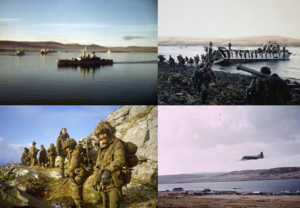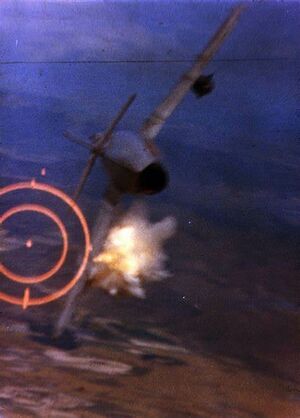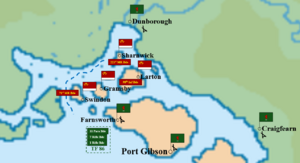Operation Featherlite: Difference between revisions
m (→Land Battles) |
m (→Swindon) |
||
| Line 44: | Line 44: | ||
The Arcer Air Force would be required to ensure air superiority was achieved over the islands to allow the ships of the Royal Arcerion Naval Service the ability to ferry and land men, equipment, and supplies to support the brigades that were preparing to land. | The Arcer Air Force would be required to ensure air superiority was achieved over the islands to allow the ships of the Royal Arcerion Naval Service the ability to ferry and land men, equipment, and supplies to support the brigades that were preparing to land. | ||
The [[Arcer General Staff]] prepared three brigades to seize the islands. 1 Rifle, 7 Rifle, and 11 Para were all moved quickly to Craigfearn and began preparations to retake the four islands of [[Foxhey Governorate|Foxhey]]. The Arcer Air Force began preparations with aerial reconnaissance flights, early usage of satellite photography, maritime reconnaissance, and working with [[Arcerion Special Operations Command]]. Members of the Special Arcerion Service Regiment had been conducting raids and reconnaissance of [[Kelekona|Kelekonese]] positions and facilities since the war's outbreak, and this helped build the intelligence picture required for the Air Force to strike. | The [[Arcer General Staff]] prepared three brigades to seize the islands. 1 Rifle, 7 Rifle, and 11 Para were all moved quickly to Craigfearn and began preparations to retake the four islands of [[Foxhey Governorate|Foxhey]]. The Arcer Air Force began preparations with aerial reconnaissance flights, early usage of satellite photography, maritime reconnaissance, and working with [[Arcerion Special Operations Command]]. Members of the Special Arcerion Service Regiment had been conducting raids and reconnaissance of [[Kelekona|Kelekonese]] positions and facilities since the war's outbreak, and this helped build the intelligence picture required for the Air Force to strike. | ||
The [[Royal Arcerion Submarine Service]] during this time had its new ''Dolphin''-class diesel electric attack submarines shadow the Kelekonese Navy, and had been conducting attacks on supply ships and other vessels bringing commerce into the Northern Malentine Sea. Sorties from [[Chester-on-Moore]] were constant and proved to be effective, as the Navy's blockade of the Warrington Strait prevented new ships from entering the Malentine Sea. | The [[Royal Arcerion Submarine Service]] during this time had its new ''Dolphin''-class diesel electric attack submarines shadow the Kelekonese Navy, and had been conducting attacks on supply ships and other vessels bringing commerce into the Northern Malentine Sea. Sorties from [[Chester-on-Moore]] were constant and proved to be effective, as the Navy's blockade of the Warrington Strait prevented new ships from entering the Malentine Sea. | ||
[[File:Shot down Kelekona aircraft.jpg|thumb|Gun camera footage from a ''Goshawk'' fighter aircraft of No.19 Squadron, Arcer Air Force shows a Kelekonan fighter being shot down over Larton Island. ]] | [[File:Shot down Kelekona aircraft.jpg|thumb|Gun camera footage from a ''Goshawk'' fighter aircraft of No.19 Squadron, Arcer Air Force shows a Kelekonan fighter being shot down over Larton Island. ]] | ||
Preparations focused on the landings, and a Task Force (Task Force 86) was organized around the Arcer aircraft carrier, the ACS ''Kurst''. Plans were for a short but aggressive air campaign, followed by landings in Farnsworth, followed by Swindon and Gramsby. During the preparations for the operation, a surprise attack by several Kelekonan destroyers and frigates on [[Port Gibson]] damaged much of the runway and support facilities. With the main military airfield in Foxhey damaged, the Arcer Air Force was forced to sortie out of Dunborough, Craigfearn, and Kinnaird. The extended times would only be cut down once the smaller runway at Farnsworth could be repaired, and with some sorties being conducted by the Naval Air Arm from the ''Kurst''. | Preparations focused on the landings, and a Task Force (Task Force 86) was organized around the Arcer aircraft carrier, the ACS ''Kurst'' and placed under the command of Vice Admiral Lawrence Thistle, who would work closely with the land contingent commander, Lieutenant General Stephen van der Berg. Plans were for a short but aggressive air campaign, followed by landings in Farnsworth, followed by Swindon and Gramsby. During the preparations for the operation, a surprise attack by several Kelekonan destroyers and frigates on [[Port Gibson]] damaged much of the runway and support facilities. With the main military airfield in Foxhey damaged, the Arcer Air Force was forced to sortie out of Dunborough, Craigfearn, and Kinnaird. The extended times would only be cut down once the smaller runway at Farnsworth could be repaired, and with some sorties being conducted by the Naval Air Arm from the ''Kurst''. | ||
The date of the invasion was set for 7 October, as the weather forecast predicted clear skies that would be favourable for air-ground coordination, and Task Force 86, now comprised of over thirty warships and supporting vessels, moved into the Malentine to avoid Kelekonan spies and reconnaissance and to maintain operational surprise. | The date of the invasion was set for 7 October, as the weather forecast predicted clear skies that would be favourable for air-ground coordination, and Task Force 86, now comprised of over thirty warships and supporting vessels, moved into the Malentine to avoid Kelekonan spies and reconnaissance and to maintain operational surprise. | ||
=== Air Combat === | === Air Combat === | ||
| Line 55: | Line 56: | ||
Failures by diplomats to resolve the crisis meant that a military conclusion to the conflict was the only remaining option, and the operation was approved by the Arcer General Staff to commence as planned in the early morning hours of 7 October. Task Force 86 moved off the coast near Farnsworth during the evening of October 6th, and a heavy bombardment of Swindon began during the night by fighter bombers of the Arcer Air Forcer and Royal Arcerion Naval Service. Swindon was defended by elements of the Kelekonan 71st Motor Rifle Brigade, which was spread out between the two islands of Swindon and Gramsby. In the dawn hours of 7 October, two battalions of Arcer infantry loaded onto helicopters to land on Swindon and secure the beachhead. | Failures by diplomats to resolve the crisis meant that a military conclusion to the conflict was the only remaining option, and the operation was approved by the Arcer General Staff to commence as planned in the early morning hours of 7 October. Task Force 86 moved off the coast near Farnsworth during the evening of October 6th, and a heavy bombardment of Swindon began during the night by fighter bombers of the Arcer Air Forcer and Royal Arcerion Naval Service. Swindon was defended by elements of the Kelekonan 71st Motor Rifle Brigade, which was spread out between the two islands of Swindon and Gramsby. In the dawn hours of 7 October, two battalions of Arcer infantry loaded onto helicopters to land on Swindon and secure the beachhead. | ||
=== Swindon === | === Swindon === | ||
The assault on Swindon caught the Kelekonan defenders by surprise. A and B Companies, 1st Battalion, Royal Arcerion Regiment quickly took over key objectives on the city's outskirts, and air strikes and naval gunfire from offshore Arcer naval vessels quickly overwhelmed the Kelekonan defenders, which were unprepared and many were caught sleeping or killed as they hastily attempted to occupy fighting positions. A final wave of helicopters landed C Company 1 RAR and additional troops from the Kinnaird Grenadier Guards, which secured Grey Beach, a popular tourist beach on the city outskirts. Kelekonan forces inside the Grey Resort had garrisoned it, and held it for most of the morning despite a heavy volume of mortar and machinegun fire. Eventually the deputy commanding officer for the 711th Motor Rifle Regiment surrendered the town, and the Task Force moved to the shoreline and began the process of landing additional troops. | |||
Engineers and signals personnel quickly set up command posts and cleared minefields laid by the Kelekonans, and two battalions of the Royal Easthampton Borderers moved Northwest inland to engage in a running battle with the battered elements of the 712th Motor Rifle Regiment which were retreating to the smaller port town of Golworth on the island's North shore. 1 Rifle Brigade continued to mop up around Swindon as small pockets of Kelekonan regular troops were in the surrounding foothills and harassed the town with mortar fire. Overhead, the Arcer Air Force had prevented the Kelekonan People's Air Force from engaging forces as they were vulnerable during landing, and a naval detachment (TF 86.1) had landed a company of the Royal Regiment of Arcerion Engineers (RRAE) to repair the damaged runway at Farnsworth, which would be operational by October 12th. | |||
=== Gramsby === | === Gramsby === | ||
Kelekonan High Command had reacted poorly to losing Swindon, and managed to use civilian boats and fishing trawlers illegally taken from the local Arcer populace to ferry their troops under the cover of darkness from Swindon to Gramsby, to the East. The 71st, now at half strength, began digging in and preparing for a more deliberate defensive battle as Arcerion no longer had the element of surprise. Van der Berg and Thistle worked with the Arcer General Staff to establish what conditions would allow for a quick movement to Gramsby. A date for the next island hop was set for October 16th, and van der Berg tasked the Royal Easthampton Borderers to conduct a daring night air assault against the island's southern shore. | |||
=== Long March at Larton === | === Long March at Larton === | ||
=== Surrender of Sharnwick === | === Surrender of Sharnwick === | ||
Revision as of 16:01, 15 May 2023
| Operation Featherlite | |||||||||
|---|---|---|---|---|---|---|---|---|---|
| Part of Telekonese Conflict | |||||||||
 | |||||||||
| |||||||||
| Belligerents | |||||||||
|
|
| ||||||||
| Units involved | |||||||||
|
1 Rifle Brigade 7 Rifle Brigade 11 Parachute Brigade |
22nd Motor Rifle Brigade 71st Motor Rifle Brigade 98th Naval Infantry Brigade | ||||||||
Operation Featherlite was the military landing of Arcer troops supported by aircraft and naval vessels on the islands of Foxhey Governorate, in an effort to retake the strategically important Gibson Gap.
Background and Preparation
The Arcer General Staff had undergone preparations to retake the islands in the Gibson Gap. The movement of three brigades, notably 7 Rifle Brigade, with its mountaineering and cold weather experience, and a large contingent from the Arcerion Parachute Regiment as part of 11 Parachute Brigade. Arriving in Craigfearn, they quickly began coordinating plans for landings and recapture of the islands, beginning first with coordinating efforts with the Arcer Air Force and Royal Arcerion Naval Service.
The Arcer Air Force would be required to ensure air superiority was achieved over the islands to allow the ships of the Royal Arcerion Naval Service the ability to ferry and land men, equipment, and supplies to support the brigades that were preparing to land.
The Arcer General Staff prepared three brigades to seize the islands. 1 Rifle, 7 Rifle, and 11 Para were all moved quickly to Craigfearn and began preparations to retake the four islands of Foxhey. The Arcer Air Force began preparations with aerial reconnaissance flights, early usage of satellite photography, maritime reconnaissance, and working with Arcerion Special Operations Command. Members of the Special Arcerion Service Regiment had been conducting raids and reconnaissance of Kelekonese positions and facilities since the war's outbreak, and this helped build the intelligence picture required for the Air Force to strike.
The Royal Arcerion Submarine Service during this time had its new Dolphin-class diesel electric attack submarines shadow the Kelekonese Navy, and had been conducting attacks on supply ships and other vessels bringing commerce into the Northern Malentine Sea. Sorties from Chester-on-Moore were constant and proved to be effective, as the Navy's blockade of the Warrington Strait prevented new ships from entering the Malentine Sea.

Preparations focused on the landings, and a Task Force (Task Force 86) was organized around the Arcer aircraft carrier, the ACS Kurst and placed under the command of Vice Admiral Lawrence Thistle, who would work closely with the land contingent commander, Lieutenant General Stephen van der Berg. Plans were for a short but aggressive air campaign, followed by landings in Farnsworth, followed by Swindon and Gramsby. During the preparations for the operation, a surprise attack by several Kelekonan destroyers and frigates on Port Gibson damaged much of the runway and support facilities. With the main military airfield in Foxhey damaged, the Arcer Air Force was forced to sortie out of Dunborough, Craigfearn, and Kinnaird. The extended times would only be cut down once the smaller runway at Farnsworth could be repaired, and with some sorties being conducted by the Naval Air Arm from the Kurst. The date of the invasion was set for 7 October, as the weather forecast predicted clear skies that would be favourable for air-ground coordination, and Task Force 86, now comprised of over thirty warships and supporting vessels, moved into the Malentine to avoid Kelekonan spies and reconnaissance and to maintain operational surprise.
Air Combat
From 1-7 October, the Arcer Air Force engaged in fierce dogfights over Foxhey, the Gibson Gap, and the Malentine Sea. Strikes against Kelekonan positions on the smaller islands were frequent, as the Air Force prepared the area for landings. The dogfights also saw the first uses of air-to-air missiles in Crona, with Arcer Goshawk fighter aircraft engaging older Kelekonan fighters, which were mostly armed with guns or very early missile designs. The Air Force was ultimately successful, and by 6 October the Kelekonan Air Force sorties remained outside the Gibson Gap, with Arcer fighters conducting combat air patrols over the islands and attacking surface-to-air missile sites. The Arcer Air Force also conducted additional aerial reconnaissance during this time as part of the bomb damage assessment after its strikes. Arcer fighters would continue to remain in support of ground troops as operation shifted from a prepatory phase and began to focus on the landings.
Land Battles

Failures by diplomats to resolve the crisis meant that a military conclusion to the conflict was the only remaining option, and the operation was approved by the Arcer General Staff to commence as planned in the early morning hours of 7 October. Task Force 86 moved off the coast near Farnsworth during the evening of October 6th, and a heavy bombardment of Swindon began during the night by fighter bombers of the Arcer Air Forcer and Royal Arcerion Naval Service. Swindon was defended by elements of the Kelekonan 71st Motor Rifle Brigade, which was spread out between the two islands of Swindon and Gramsby. In the dawn hours of 7 October, two battalions of Arcer infantry loaded onto helicopters to land on Swindon and secure the beachhead.
Swindon
The assault on Swindon caught the Kelekonan defenders by surprise. A and B Companies, 1st Battalion, Royal Arcerion Regiment quickly took over key objectives on the city's outskirts, and air strikes and naval gunfire from offshore Arcer naval vessels quickly overwhelmed the Kelekonan defenders, which were unprepared and many were caught sleeping or killed as they hastily attempted to occupy fighting positions. A final wave of helicopters landed C Company 1 RAR and additional troops from the Kinnaird Grenadier Guards, which secured Grey Beach, a popular tourist beach on the city outskirts. Kelekonan forces inside the Grey Resort had garrisoned it, and held it for most of the morning despite a heavy volume of mortar and machinegun fire. Eventually the deputy commanding officer for the 711th Motor Rifle Regiment surrendered the town, and the Task Force moved to the shoreline and began the process of landing additional troops.
Engineers and signals personnel quickly set up command posts and cleared minefields laid by the Kelekonans, and two battalions of the Royal Easthampton Borderers moved Northwest inland to engage in a running battle with the battered elements of the 712th Motor Rifle Regiment which were retreating to the smaller port town of Golworth on the island's North shore. 1 Rifle Brigade continued to mop up around Swindon as small pockets of Kelekonan regular troops were in the surrounding foothills and harassed the town with mortar fire. Overhead, the Arcer Air Force had prevented the Kelekonan People's Air Force from engaging forces as they were vulnerable during landing, and a naval detachment (TF 86.1) had landed a company of the Royal Regiment of Arcerion Engineers (RRAE) to repair the damaged runway at Farnsworth, which would be operational by October 12th.
Gramsby
Kelekonan High Command had reacted poorly to losing Swindon, and managed to use civilian boats and fishing trawlers illegally taken from the local Arcer populace to ferry their troops under the cover of darkness from Swindon to Gramsby, to the East. The 71st, now at half strength, began digging in and preparing for a more deliberate defensive battle as Arcerion no longer had the element of surprise. Van der Berg and Thistle worked with the Arcer General Staff to establish what conditions would allow for a quick movement to Gramsby. A date for the next island hop was set for October 16th, and van der Berg tasked the Royal Easthampton Borderers to conduct a daring night air assault against the island's southern shore.